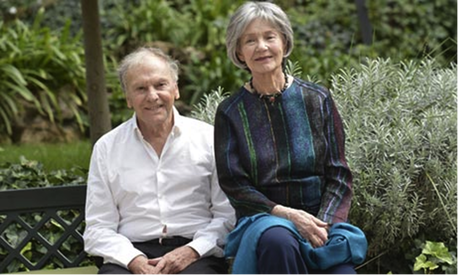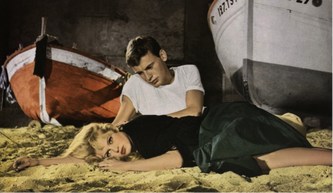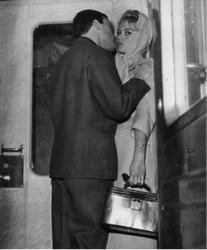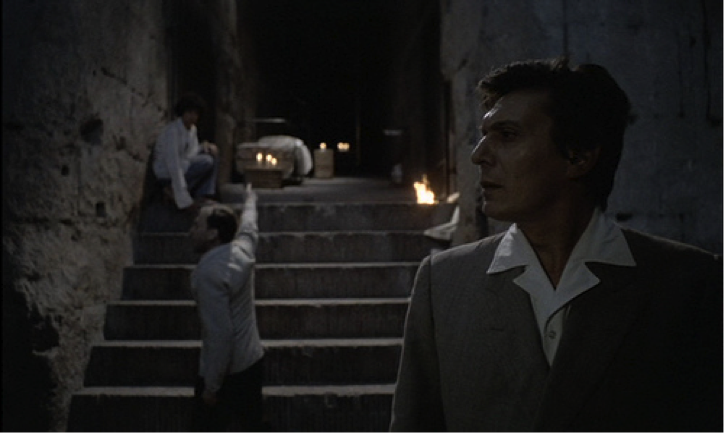Ageless: The Film Careers of Amour’s Jean-Louis Trintignant and Emmanuelle Riva
|
|
“As Barny, the stunningly complex Riva emits a fabulous array of restive expressions, flashing between defiance and abjection, pleasure and anxiety, assurance and perplexity. The range of feeling that registers on her face is perhaps the most appealing feature of Léon Morin. Her eyes convey a severe intelligence that will always rescue her from pettiness. If Barny seems destroyed in the end, it’s easy to imagine her recovering self-possession” (Indiana 10).
|
In Thérèse Desqueyroux (Georges Franju, 1962), Riva continues to demonstrate her abilities as the title character, whose loveless marriage to a wealthy landowner leaves her condemned to a life of isolation after an unsuccessful attempt at murder. Throughout the film, Riva’s character is constantly engaged in a mental struggle between the security of her position and her personal freedom, which similar to Hiroshima, utilizes flashbacks, and close-ups for emphasis. Riva is able to capture this conflicted nature through her trance-like movements, eyes, and facial expressions. In his most well-known film; The Conformist (Bernardo Bertolucci, 1970), Trintignant’s instinctive acting ability enabled him to give a very realistic performance as Marcello Clerici, an Italian fascist who’s assigned to kill a political refugee in Paris. The film explores the origins of his allegiance to fascism, and how it affects his need to be “normal” (Erickson). Through his mask-like facial expression, he hides his deepest fears of being “different” (eg. homosexual, murderer) (Bertolucci). In the last scene when Marcello sees the same man who he thought he had killed as child was actually alive, his whole reason for being a fascist is completely unraveled. It’s within this context that Trintignant demonstrates his ability to express the raw emotion of the character. In an interview with Molly Haskell in 1970, Trintignant described his approach to this scene;
|
“When I see this man, and my entire life is invalidated, I go crazy. So we did the scene, and I really did go crazy. For a few minutes I went berserk. It was fantastic! I’ve never done anything like it, never been able to. And I realized how most of the time I-and all actors-only give a fraction of what is possible. You are tired or inhibited by the crew or whatever. And, in fact, the crew thought this was terrible. ‘Hadn’t we better shoot it over?’ they asked Bertolucci. But it was the truth, the real thing, and because they had never seen it they didn’t recognize it! They were so used to people, me included just walking through their parts that when somebody played it like it was supposed to be played they thought he was crazy. Of course I was a little, because that was the part” (Haskell 38).
|
This best illustrates Trintignant’s philosophy of “living the role” which closely resembles Stanislavski’s “method” type of acting. Riva, also has a similar philosophy, stating recently in an interview; “I recently read a statement by the great filmmaker Carl Dreyer. He said; ‘I do not ask an actor to perform, I just wait till something happens to him or her that he or she doesn’t know they had inside them.’ “That really summarized my view of my job: something happens to me that I don’t know I had inside me” (Maddox “Love and tenderness”). Both Trintignant and Riva share this instinctive approach to acting which has enabled them to play emotionally complex characters throughout their careers. This was especially true in Krzysztof Kieslowski’s Three Colors where both their careers converged, to play mature characters in the first and third parts of the trilogy. In the first part Blue (Krzysztof Kieslowski, 1993), Riva plays an aging mother of the film’s protagonist Julie. In Red (Krzysztof Kieslowski, 1994), the final film of the trilogy, Trintignant portrays a retired judge. Their ability to internalize these emotions associated with aging, is what makes a film like Amour so powerful. Jean-Louis Trintignant once asserted; “The best actors in the world, are those who feel the most and show the least” (IMDB). If truly the best actors are those who “feel the most,” then these two are ageless.
Works Cited:
A Man and A Woman. Dir. Claude Lelouch. Perf., Anouk Aimée Jean-Louis Trintignant. Les Films 13, 1966. VHS.
And God Created Woman. Dir. Roger Vadim. Perf. Brigitte Bardot, Cürd Jurgens, Jean-Louis Trintignant. Cocinar, 1956. Dailymotion.com. DailyMotion, 18 Oct. 2011. Web. 19 Apr. 2013. <http://www.dailymotion.com/video/xlrx67_and-god-created-woman_shortfilms>.
Cowie, Peter. audio commentary. Hiroshima mon amour. Dir. Alain Resnais. The Criterion Collection. 2003. DVD
Erickson, Hal. The Conformist Review Summary. The New York Times. Web. 28, April 2013. http://movies.nytimes.com/movie/10775/The-Conformist/overview
Haskell, Molly. “Jean-Louis Trintignant: The Life and Times of a Secret Superstar.” Show. 20, Aug. 1970. Print.
Hiroshima mon amour. Dir. Alain Resnais. Perf. Emmanuelle Riva, Eiji Okada. Argos Films, 1959. DVD.
Indiana, Gary. "Léon Morin, Priest: Life During Wartime." Criterion.com. The Criterion Collection, 26 July 2011. Web. 07 May 2013.
“Jean-Louis Trintignant.” Internet Movie Database. Internet Movie Database. Web. 15, April 2013
Léon Morin, Priest. Dir. Jean-Pierre Melville. Perf. Jean-Paul Belmondo, Emmanuelle Riva. Concordia Compagnia Cinematografica, 1961. DVD.
Maddox, Gary. “Love and tenderness.” The Sydney Morning Herald. 22 Feb. 2013. Web. 28 April 2013.
The Conformist. Dir. Benardo Bertolucci. Perf. Jean-Louis Trintignant, Stefania Sandrelli, Gastone Moschin, Dominique Sanda, Pierre Clementi. Mars Film, 1970. DVD.
“The Rise of The Conformist: The Story, The Cast.” The Conformist. Dir. Benardo Bertolucci. Paramount Pictures, 2006. DVD
Thérèse Desqueyroux. Dir. Georges Franju. Perf. Emmanuelle Riva, Philippe Noiret,
Edith Scob. Filmel, 1962. Youtube.com. Youtube, 3 Feb. 2013. Web. 27 Apr. 2013. <http://www.youtube.com/watch?v=ix8ZEqsyY9o>.
Three Colors: Blue. Dir. Krzysztof Kieslowski. Perf. Juliette Binoche, Benoit Regent, Emmanuelle Riva. MK2 Productions, 1993. DVD.
Three Colors: Red. Dir. Krzysztof Kieslowski. Perf. Irene Jacob, Jean-Louis Trintignant, Frederique Feder, Jean-Pierre Lorit. MK2 Productions, 1994. DVD
Vincendeau, Ginette. audio commentary. Léon Morin, Priest. Jean-Pierre Melville. The Criterion Collection. 2011. DVD
Vincendeau, Ginette. Stars and Stardom in French Cinema. London and New York: Continuum, 2000. Print.
A Man and A Woman. Dir. Claude Lelouch. Perf., Anouk Aimée Jean-Louis Trintignant. Les Films 13, 1966. VHS.
And God Created Woman. Dir. Roger Vadim. Perf. Brigitte Bardot, Cürd Jurgens, Jean-Louis Trintignant. Cocinar, 1956. Dailymotion.com. DailyMotion, 18 Oct. 2011. Web. 19 Apr. 2013. <http://www.dailymotion.com/video/xlrx67_and-god-created-woman_shortfilms>.
Cowie, Peter. audio commentary. Hiroshima mon amour. Dir. Alain Resnais. The Criterion Collection. 2003. DVD
Erickson, Hal. The Conformist Review Summary. The New York Times. Web. 28, April 2013. http://movies.nytimes.com/movie/10775/The-Conformist/overview
Haskell, Molly. “Jean-Louis Trintignant: The Life and Times of a Secret Superstar.” Show. 20, Aug. 1970. Print.
Hiroshima mon amour. Dir. Alain Resnais. Perf. Emmanuelle Riva, Eiji Okada. Argos Films, 1959. DVD.
Indiana, Gary. "Léon Morin, Priest: Life During Wartime." Criterion.com. The Criterion Collection, 26 July 2011. Web. 07 May 2013.
“Jean-Louis Trintignant.” Internet Movie Database. Internet Movie Database. Web. 15, April 2013
Léon Morin, Priest. Dir. Jean-Pierre Melville. Perf. Jean-Paul Belmondo, Emmanuelle Riva. Concordia Compagnia Cinematografica, 1961. DVD.
Maddox, Gary. “Love and tenderness.” The Sydney Morning Herald. 22 Feb. 2013. Web. 28 April 2013.
The Conformist. Dir. Benardo Bertolucci. Perf. Jean-Louis Trintignant, Stefania Sandrelli, Gastone Moschin, Dominique Sanda, Pierre Clementi. Mars Film, 1970. DVD.
“The Rise of The Conformist: The Story, The Cast.” The Conformist. Dir. Benardo Bertolucci. Paramount Pictures, 2006. DVD
Thérèse Desqueyroux. Dir. Georges Franju. Perf. Emmanuelle Riva, Philippe Noiret,
Edith Scob. Filmel, 1962. Youtube.com. Youtube, 3 Feb. 2013. Web. 27 Apr. 2013. <http://www.youtube.com/watch?v=ix8ZEqsyY9o>.
Three Colors: Blue. Dir. Krzysztof Kieslowski. Perf. Juliette Binoche, Benoit Regent, Emmanuelle Riva. MK2 Productions, 1993. DVD.
Three Colors: Red. Dir. Krzysztof Kieslowski. Perf. Irene Jacob, Jean-Louis Trintignant, Frederique Feder, Jean-Pierre Lorit. MK2 Productions, 1994. DVD
Vincendeau, Ginette. audio commentary. Léon Morin, Priest. Jean-Pierre Melville. The Criterion Collection. 2011. DVD
Vincendeau, Ginette. Stars and Stardom in French Cinema. London and New York: Continuum, 2000. Print.





